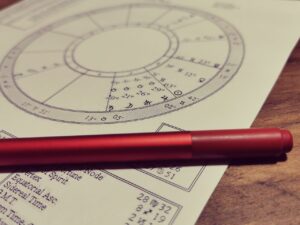
Since ancient times, humans have looked up at the stars and planets, seeking answers to life’s mysteries and trying to decipher the universe’s grand design. Among the various branches of astrology, one fundamental aspect that plays a crucial role in shaping our individuality and life experiences is the concept of houses.
Western astrology, a time-honoured tradition that has captured the fascination of civilizations for millennia, employs a complex system of twelve houses, each representing a distinct domain of human existence. These houses serve as cosmic blueprints that interweave with the positions of celestial bodies in our birth charts, unveiling the potentialities and challenges that await us on our journey through life.
The Foundation of Houses
In Western astrology, a birth chart, also known as a natal chart or horoscope, is an intricate snapshot of the heavens at the exact moment of an individual’s birth. It is a personalised map that details the positions of the Sun, Moon, planets, and other celestial bodies relative to the Earth. The twelve houses in the chart are crucial components of this celestial map.
The houses are like distinct rooms in the grand mansion of astrology. Each house governs specific aspects of our lives, influencing our personality traits, relationships, career, and spiritual growth. These cosmic divisions unveil the specific arenas of human existence where the interplay of celestial energies shapes our experiences and influences our journey through life.
The Significance of Each House
The First House: This house represents the self, physical appearance, and the way we project ourselves to the world. It unveils our initial approach to life and the impression we leave on others. The first house sets the stage for the rest of the chart, revealing our inherent qualities and how we meet the world with our unique personality.
The Ascendant (ASC) is the zodiac sign that was rising on the eastern horizon at the moment of a person’s birth and represents the cusp of the first house.
The Second House: Linked to material possessions, finances, and self-worth, the second house reflects our attitude towards money and the resources we accumulate. It governs our relationship with material stability and how we derive value from the things we possess.
The Third House: Governing communication, learning, and siblings, this house sheds light on our intellectual pursuits and the way we interact with the world around us. It reveals how we process information, connect with others through language, and develop our mental faculties.
The Fourth House: Associated with home, family, and roots, the fourth house delves into our sense of belonging, emotional foundation, and domestic life. It reflects our relationship with our family and origins, as well as our need for security and emotional well-being.
The Imum Coeli (IC) is the point that represents the cusp of the fourth house, located at the lowest point in the birth chart.
The Fifth House: This house is associated with creativity, romance, children, and pleasures. It unravels our capacity for self-expression, our artistic inclinations, and how we seek joy and enjoyment in life.
The Sixth House: Focused on health, daily routines, and work, the sixth house guides us in matters of service, duty, and overall well-being. It pertains to our work ethic, how we handle responsibilities, and our approach to maintaining physical and mental health.
The Seventh House: Centred around partnerships and relationships, this house highlights our approach to love and collaboration with others. It represents the qualities we seek in a partner and the dynamics we experience in one-on-one relationships.
The Descendant (DSC) is the opposite point to the Ascendant (ASC), located on the western horizon and represents the cusp of the seventh house.
The Eighth House: Known as the realm of transformation and shared resources, the eighth house delves into life’s deeper mysteries, including death, regeneration, and sexuality. It relates to our capacity for intimacy, the merging of resources in partnerships, and our understanding of life’s profound transformations.
The Ninth House: Governing higher education, philosophy, and spirituality, this house inspires our quest for knowledge and broader understanding of the world. It is associated with our belief systems, spiritual pursuits, and our desire for expanding our horizons through learning and exploration.
The Tenth House: Linked to career, public image, and achievements, the tenth house reveals our ambitions and aspirations on the worldly stage. It represents our vocational path, the public image we project, and our desire for recognition and success in our chosen field.
The Midheaven (MC) is the point that represents the cusp of the tenth house, located at the highest point in the birth chart.
The Eleventh House: Focused on community, friendships, and social ideals, this house encourages collaboration and collective endeavours. It reflects our involvement in groups, associations, and the causes we support.
The Twelfth House: Associated with the subconscious, spirituality, and hidden realms, the twelfth house provides insight into our spiritual journey and the hidden aspects of our psyche. It relates to our unconscious patterns, the collective unconscious, and our connection to the divine.
The Dynamic Interplay of Houses
The positions of planets within each house, as well as the interactions between them, create a rich tapestry of energies that shape our lives. As the celestial bodies move through the houses and form astrological aspects, they trigger various events and experiences, impacting our growth, challenges, and opportunities.
Understanding the significance of houses in Western astrology opens a gateway to self-discovery, offering profound insights into our strengths, weaknesses, and the patterns that influence our lives. By exploring the intricacies of our natal chart, we gain the wisdom to make conscious choices, embrace personal growth, and navigate life’s ever-changing cosmic dance.
In Western astrology, the houses play a crucial role in understanding different aspects of our lives. They function as guides, helping us explore our personality traits, relationships, and life’s journey. By studying the houses in our birth chart, we can gain valuable insights into ourselves and the world around us. So, let the houses be your compass as you navigate the complexities of life and discover the mysteries they hold.
References
Woolfolk, Joanna Martine. The Only Astrology Book You’ll Ever Need. Taylor Trade Publishing, 2008.
Forrest, Steven. The Inner Sky: How to Make Wiser Choices for a More Fulfilling Life. Seven Paws Press, 2001.
Parker, D., & Parker, J.. The Astrology Book: The Encyclopedia of Heavenly Influences. DK, 2009.
Sasportas, Howard. The Twelve Houses: Exploring the houses of the horoscope. Flare Publications, 1985.
Houlding, Deborah. The Houses: Temples of the Sky. Wessex, 2006.
Notes:
[1] In astrology, the planets represent fundamental principles. The houses, on the other hand, show events, which represent the areas of life or specific life domains, while the zodiac acts as a bridge connecting the planets and houses. Positioned between the planets and the houses, the zodiac unveils the intentions, emotions, and underlying elements within the horoscope.
According to Steven Forrest, “Planets tell us which part of the mind we are looking at (the what). Signs let us know what needs and strategies drive that planet (the why and the how). Houses specify in exactly which of life’s arenas that planet-sign combination is developing (the where)” (The Inner Sky, 2001).
